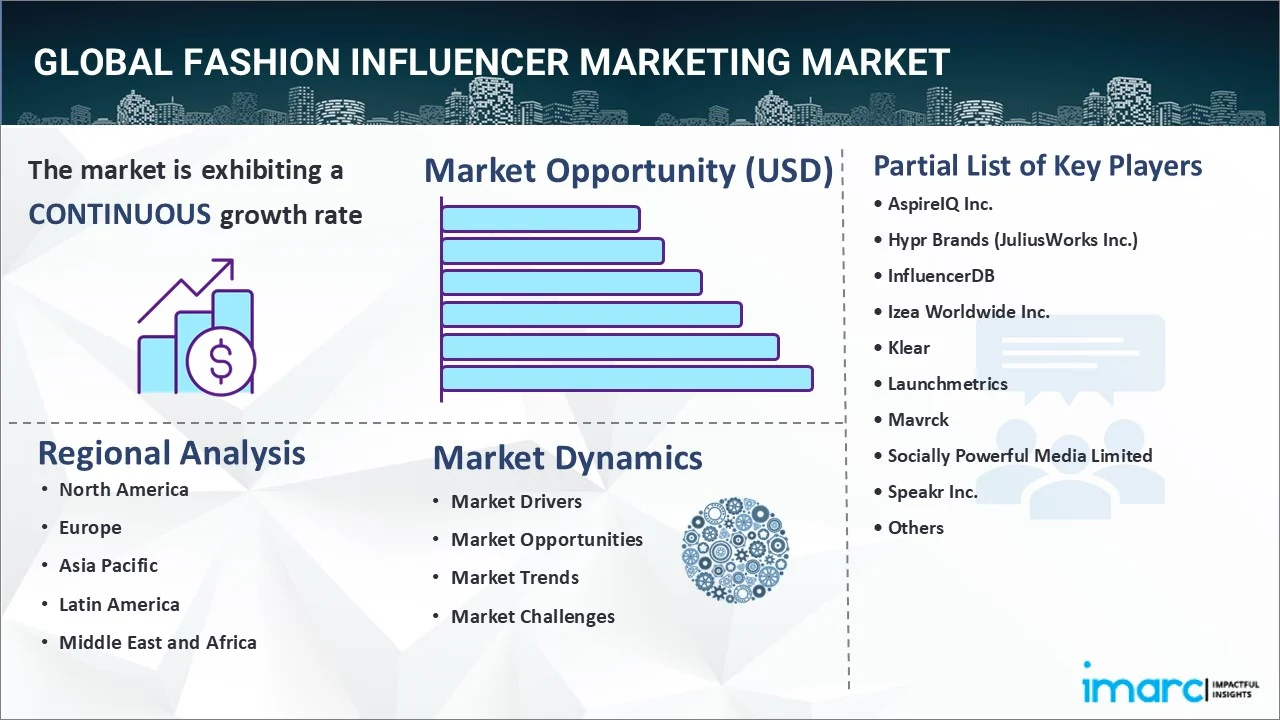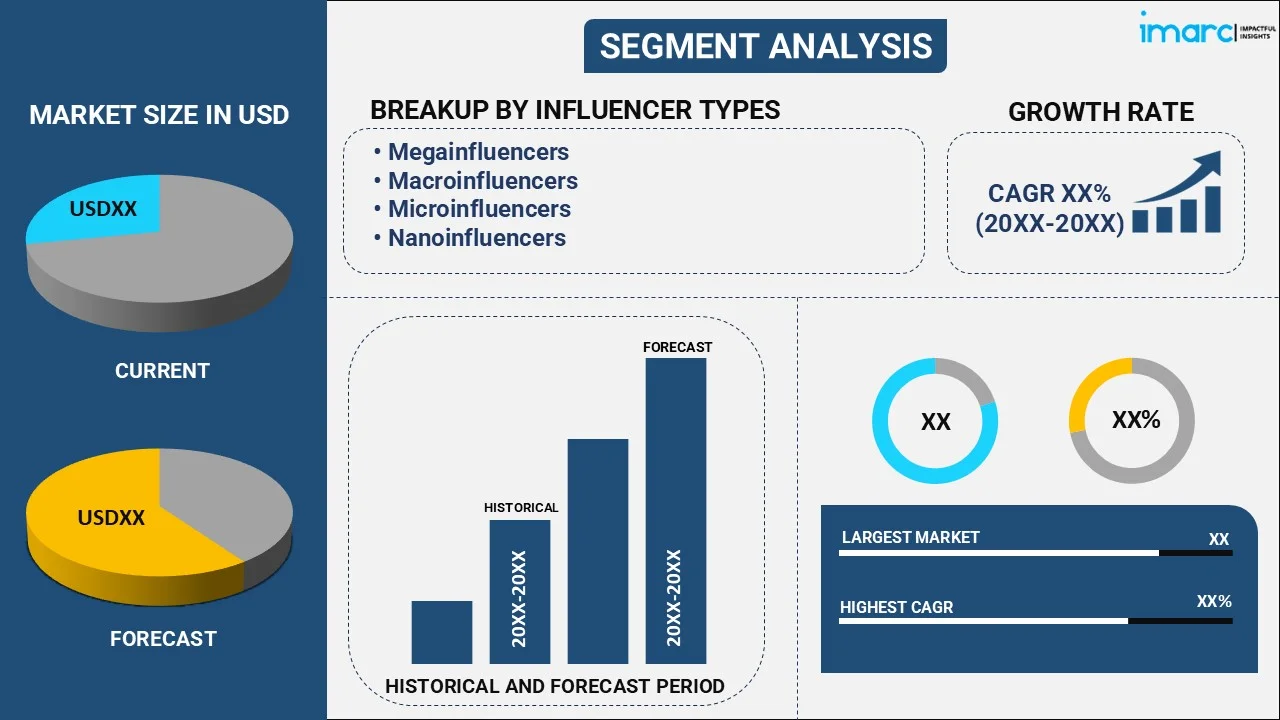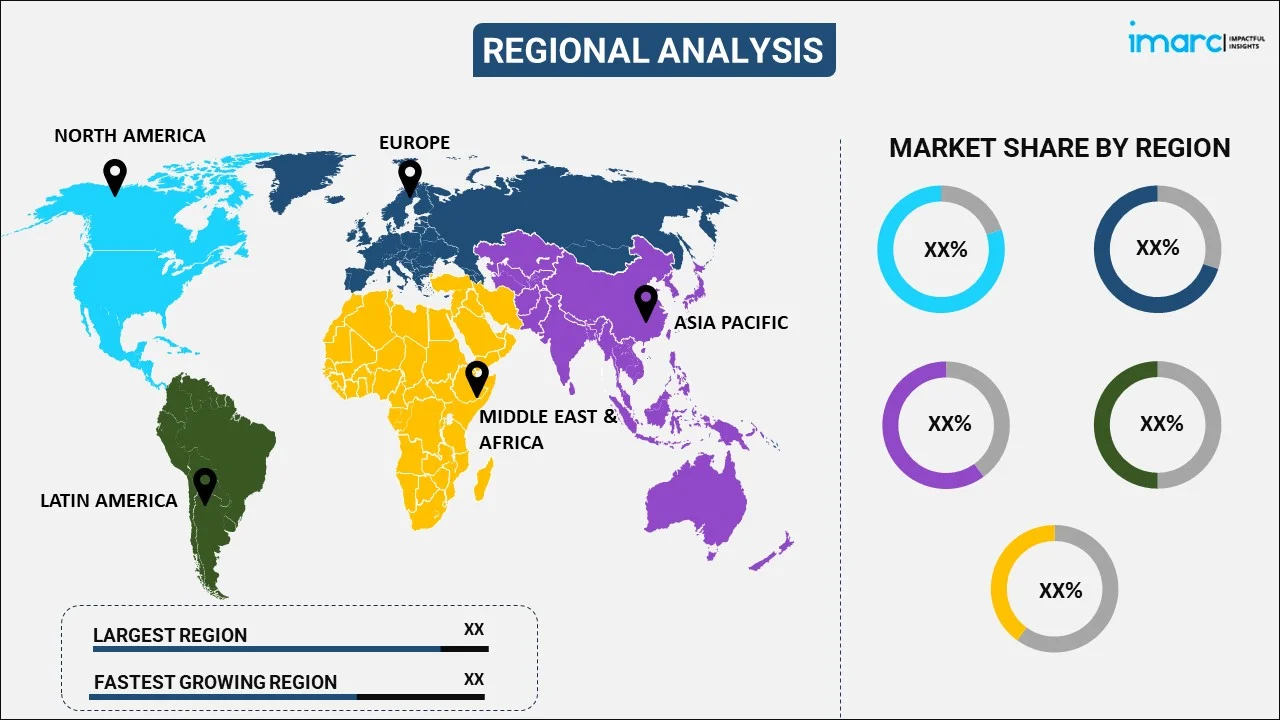
Fashion Influencer Marketing Market Report by Influencer Type (Megainfluencers, Macroinfluencers, Microinfluencers, Nanoinfluencers), Fashion Type (Beauty and Cosmetics, Apparels, Jewelry and Accessories), and Region 2025-2033
Fashion Influencer Marketing Market 2024, Size And Trends
The global fashion influencer marketing market size reached USD 6.8 Billion in 2024. Looking forward, IMARC Group expects the market to reach USD 96.7 Billion by 2033, exhibiting a growth rate (CAGR) of 34.3% during 2025-2033. The rise of social media platforms, the emphasis on authenticity and relatability, the evolution of innovative content formats, measurable impact and analytics, and the diverse influencer types catering to specific audience segments and industry niches represent some of the key factors propelling the fashion influencer market.
|
Report Attribute
|
Key Statistics
|
|---|---|
|
Base Year
|
2024
|
|
Forecast Years
|
2025-2033
|
|
Historical Years
|
2019-2024
|
|
Market Size in 2024
|
USD 6.8 Billion |
|
Market Forecast in 2033
|
USD 96.7 Billion |
| Market Growth Rate 2025-2033 | 34.3% |
Fashion Influencer Marketing Market Analysis:
- Market Growth and Size: The global fashion influencer marketing market is experiencing robust growth, driven by the increasing integration of social media platforms and the expanding role of influencers in shaping consumer preferences. The market size is substantial, reflecting the fashion industry's recognition of influencers as powerful brand advocates, with spending on influencer marketing reaching billions of dollars annually.
- Major Market Drivers: Influencer marketing is primarily driven by the rise of social media platforms, the emphasis on authenticity and relatability, and the evolution of diverse content formats that resonate with a wide range of audiences.
- Technological Advancements: Technological advancements like augmented reality (AR), virtual try-ons, and advanced analytics enhancing the overall effectiveness of influencer campaigns play a crucial role in shaping influencer marketing. Besides this, live streaming on social media platforms showcases the dynamic nature of technological innovations, creating immersive brand interactions and driving engagement.
- Industry Applications: Fashion influencer marketing finds applications across various sectors, notably beauty and cosmetics, apparel, and jewelry/accessories, each leveraging influencers to showcase products, and trends, and create personalized connections with consumers.
- Key Market Trends: Key trends include the increasing use of nanoinfluencers for hyper-localized impact, the professionalization of influencer marketing with measurable analytics, and the incorporation of innovative content formats like live streaming and virtual try-on.
- Geographical Trends: Geographically, North America offers a mature influencer marketing ecosystem, while Asia Pacific benefits from diverse consumer markets and influencers acting as cultural connectors. Europe and Latin America thrive on fashion-forward cultures, and the Middle East and Africa bridge global trends with local preferences.
- Competitive Landscape: The competitive landscape is diverse, encompassing influencers, agencies, and social media platforms. Influencer marketing agencies facilitate collaborations, while social media platforms serve as battlegrounds for market dominance.
- Challenges and Opportunities: Challenges include maintaining authenticity as the market grows, navigating diverse regulations, and addressing issues of influencer credibility. Opportunities lie in the continued growth of the market, the exploration of new content formats, and the expansion of influencer marketing into untapped regions and industries.

Fashion Influencer Marketing Market Trends:
Rise of social media platforms
The proliferation of social media platforms is a primary driver behind the growth of fashion influencer marketing. These platforms have become integral parts of people's daily lives, providing a space for influencers to showcase their style and fashion preferences. The visual nature of these platforms aligns perfectly with the fashion industry, allowing influencers to share curated content, outfit inspirations, and product recommendations with a vast audience.
Moreover, they have emerged as a powerhouse for fashion influencers, with their visually appealing grid layout and features like stories and reels. Consequently, brands are recognizing the potential of leveraging influencers on these platforms to reach a wider audience and create a more authentic connection with consumers.
Authenticity and relatability
Authenticity and relatability have become crucial elements in consumer-brand relationships, and fashion influencers excel in delivering these qualities. Compared to traditional advertising, where messages are often scripted and polished, influencers offer a more authentic and personal connection with their audience. Many followers perceive influencers as relatable individuals who share similar lifestyles, interests, and aspirations. Brands leverage this authenticity by partnering with influencers who align with their values and target demographic. In line with this, consumers are more likely to trust product recommendations from influencers they feel a genuine connection with, leading to increased brand credibility and loyalty. Additionally, authenticity also plays a role in the content creation process, as influencers often integrate products seamlessly into their daily lives, making promotional content feel less intrusive and more natural.
Innovative content formats
The evolution of content formats has played a pivotal role in the success of fashion influencer marketing. Influencers continually explore innovative ways to present fashion content, ranging from visually stunning photoshoots to engaging video content. The use of storytelling, behind-the-scenes footage, and interactive features enhances the overall consumer experience and captures the attention of a diverse audience, creating a positive outlook for market expansion. Live streaming virtual try-on experiences, augmented reality (AR) filters and interactive polls on social media platforms create immersive brand interactions. By embracing these diverse content formats, influencers keep their content fresh and engaging, fostering a dynamic relationship with their audience and the brands they promote.
Measurable impact and analytics
The ability to measure the impact of influencer marketing campaigns is a crucial factor driving its continued growth. The increasing demand for measurable results and analytics among brands to justify their investments in influencer collaborations is contributing to the market growth. Social media platforms provide robust analytics tools that enable brands to track key performance indicators (KPIs) such as engagement, reach, conversion rates, and return on investment (ROI). These analytics allow brands to identify the most effective influencers, optimize content strategies, and refine targeting for future campaigns. This data-driven approach enhancing the overall effectiveness of influencer marketing makes it a more accountable and strategic component of a brand's marketing mix, attracting both brands and influencers who seek measurable outcomes from their collaborations.
Fashion Influencer Marketing Industry Segmentation:
IMARC Group provides an analysis of the key trends in each segment of the market, along with forecasts at the global, regional, and country levels for 2025-2033. Our report has categorized the market based on influencer type and fashion type.
Breakup by Influencer Type:

- Megainfluencers
- Macroinfluencers
- Microinfluencers
- Nanoinfluencers
Nanoinfluencers account for the majority of the market share
The report has provided a detailed breakup and analysis of the market based on the influencer type. This includes megainfluencers, macroinfluencers, microinfluencers and nanoinfluencers. According to the report, nanoinfluencers represented the largest segment.
Nanoinfluencers, characterized by individuals with smaller but highly engaged follower bases, typically ranging from 1,000 to 10,000 are gaining prominence due to their hyper-localized impact and authentic connections with niche audiences. Brands are drawn to their ability to foster genuine relationships, as nanoinfluencers often have a more personal rapport with their followers, enhancing the relatability factor and contributing to a more community-driven approach in fashion marketing strategies.
In contrast, megainfluencers, with follower counts in the millions, drive demand through their broad reach and celebrity status, offering brands massive visibility and the potential to tap into diverse global markets.
Concurrently, macroinfluencers, with follower counts between 100,000 and 1 million, strike a balance between reach and engagement, making them attractive to brands seeking wide exposure and meaningful connections.
Apart from this, microinfluencers, with follower counts ranging from 10,000 to 100,000, cater to niche audiences, leveraging their authenticity and relatability to create impactful, targeted campaigns that resonate with specific consumer segments.
Breakup by Fashion type:
- Beauty and Cosmetics
- Apparels
- Jewelry and Accessories
Beauty and Cosmetics holds the largest share in the industry
A detailed breakup and analysis of the market based on the fashion type have also been provided in the report. This includes beauty and cosmetics, apparels, and jewelry and accessories. According to the report, beauty and cosmetics accounted for the largest market share.
The demand for fashion influencer marketing is significantly driven by the beauty and cosmetics sector, where visual appeal and demonstration are paramount. Beauty influencers, equipped with makeup tutorials, skincare routines, and product reviews, effectively showcase the application and benefits of cosmetic products. The industry relies on these influencers to create engaging and authentic content, fostering a direct connection with consumers and influencing purchasing decisions. Furthermore, the visual nature of beauty content on social media platforms makes it an ideal space for impactful influencer collaborations in the beauty and cosmetics realm.
In addition to this, the ability of influencers to showcase diverse styles, trends, and outfit inspirations, offering brands a dynamic platform to connect with fashion-forward audiences and drive sales makes them a key component in the marketing strategy of various apparel companies.
Moreover, in the jewelry and accessories sector, influencer marketing is propelled by the visual nature of these products, as influencers can creatively showcase how accessories complement different looks, influencing consumer preferences and creating a personalized connection between the brand and the audience.
Breakup by Region:

- North America
- United States
- Canada
- Asia Pacific
- China
- Japan
- India
- South Korea
- Australia
- Indonesia
- Others
- Europe
- Germany
- France
- United Kingdom
- Italy
- Spain
- Russia
- Others
- Latin America
- Brazil
- Mexico
- Others
- Middle East and Africa
North America leads the market, accounting for the largest fashion influencer marketing market share
The market research report has also provided a comprehensive analysis of all the major regional markets, which include North America (the United States and Canada); Asia Pacific (China, Japan, India, South Korea, Australia, Indonesia, and others); Europe (Germany, France, the United Kingdom, Italy, Spain, Russia, and others); Latin America (Brazil, Mexico, and others); and the Middle East and Africa. According to the report, North America accounted for the largest market share.
North America’s tech-savvy consumer base highly engaged on social media represents one of the key factors driving the growth of fashion influencer marketing. The region's cultural diversity necessitates targeted marketing strategies, and influencers serve as authentic cultural connectors, facilitating brands in building a nuanced rapport with diverse audiences. Additionally, the region's mature influencer marketing ecosystem, advanced analytics infrastructure, and the strong presence of influential content creators contribute to the sustained growth and effectiveness of fashion influencer marketing in North America.
Besides this, in the Asia Pacific, the vast and diverse consumer demographic is acting as another significant growth-inducing factor, with influencers bridging cultural disparities, aligning brands with local preferences, and driving engagement.
Concurrently, Europe's fashion-forward culture and influencers' ability to showcase diverse styles and trends, fostering brand affinity is presenting lucrative opportunities for market expansion.
Apart from this, the influencers' capacity to connect with vibrant local cultures in Latin America, offering brands an avenue to tap into unique markets and establish authentic connections is providing an impetus to the market growth.
Furthermore, the surging adoption of influencer marketing to bridge the gap between global fashion trends and local preferences in the Middle East and Africa, creating a dynamic space for brand engagement is propelling the market forward.
Leading Key Players in the Fashion Influencer Marketing Industry:
The competitive landscape of the global fashion influencer marketing market is characterized by a diverse array of influencers, agencies, and platforms vying for attention in an ever-expanding digital ecosystem. Influencer marketing agencies have emerged to facilitate collaborations, offering services such as influencer identification, campaign management, and performance analytics. Social media platforms serve as battlegrounds for influencer marketing dominance, with each platform offering distinct features and engagement opportunities. Brands navigate this landscape by strategically aligning with influencers whose values and audience demographics match their marketing goals. The increasing professionalization of influencer marketing, coupled with the emphasis on data-driven strategies, adds complexity to the competitive dynamics, as brands seek measurable outcomes and genuine connections in the highly dynamic and influential world of fashion marketing.
The market research report has provided a comprehensive analysis of the competitive landscape. Detailed profiles of all major companies have also been provided. Some of the key players in the market include:
- AspireIQ Inc.
- Hypr Brands (JuliusWorks Inc.)
- InfluencerDB
- Izea Worldwide Inc.
- Klear
- Launchmetrics
- Mavrck
- Socially Powerful Media Limited
- Speakr Inc.
- Upfluence Incorporated
(Please note that this is only a partial list of the key players, and the complete list is provided in the report.)
Latest News:
- In December 2023, IZEA Worldwide, Inc. announced its headline sponsorship of Creator Economy Live 2024, bringing together top creators, influencers, brands, and industry professionals to discuss, and collaborate.
- In November 2023, Owler, a Meltwater offering launched a groundbreaking addition to its sales intelligence solution - Owler AI, a revolutionary new sales writing tool that helps sales professionals draft emails, LinkedIn messages, and perfect voicemails.
- In April 2022 Launchmetrics announced its partnership with Daydreamer, a regional media, communications, and branding agency to offer brand performance tools and insights that can help brands make smarter decisions around their branding efforts.
Fashion Influencer Marketing Market Report Scope:
| Report Features | Details |
|---|---|
| Base Year of the Analysis | 2024 |
| Historical Period | 2019-2024 |
| Forecast Period | 2025-2033 |
| Units | Billion USD |
| Scope of the Report | Exploration of Historical Trends and Market Outlook, Industry Catalysts and Challenges, Segment-Wise Historical and Future Market Assessment:
|
| Influencer Types Covered | Megainfluencers, Macroinfluencers, Microinfluencers, Nanoinfluencers |
| Fashion Types Covered | Beauty and Cosmetics, Apparels, Jewelry and Accessories |
| Regions Covered | Asia Pacific, Europe, North America, Latin America, Middle East and Africa |
| Countries Covered | United States, Canada, Germany, France, United Kingdom, Italy, Spain, Russia, China, Japan, India, South Korea, Australia, Indonesia, Brazil, Mexico |
| Companies Covered | AspireIQ Inc., Hypr Brands (JuliusWorks Inc.), InfluencerDB, Izea Worldwide Inc., Klear, Launchmetrics, Mavrck, Socially Powerful Media Limited, Speakr Inc., Upfluence Incorporated, etc. |
| Customization Scope | 10% Free Customization |
| Post-Sale Analyst Support | 10-12 Weeks |
| Delivery Format | PDF and Excel through Email (We can also provide the editable version of the report in PPT/Word format on special request) |
Key Benefits for Stakeholders:
- IMARC’s industry report offers a comprehensive quantitative analysis of various market segments, historical and current market trends, market forecasts, and dynamics of the fashion influencer marketing market from 2019-2033.
- The research report provides the latest information on the market drivers, challenges, and opportunities in the global fashion influencer marketing market.
- The study maps the leading, as well as the fastest-growing, regional markets. It further enables stakeholders to identify the key country-level markets within each region.
- Porter's five forces analysis assists stakeholders in assessing the impact of new entrants, competitive rivalry, supplier power, buyer power, and the threat of substitution. It helps stakeholders to analyze the level of competition within the fashion influencer marketing industry and its attractiveness.
- The competitive landscape allows stakeholders to understand their competitive environment and provides insight into the current positions of key players in the market
Key Questions Answered in This Report
We expect the global fashion influencer marketing market to exhibit a CAGR of 34.3% during 2025-2033.
The increasing adoption of fashion influencer marketing by various fashion brands to effectively promote, maximize the reach, and gather a broader audience of their products, is primarily driving the global fashion influencer marketing market.
The sudden outbreak of the COVID-19 pandemic has led to the rising focus on fashion influencer marketing for promoting and endorsing fashion apparel and accessories on numerous social media platforms.
Based on the influencer type, the global fashion influencer marketing market has been segmented into megainfluencers, macroinfluencers, microinfluencers, and nanoinfluencers. Among these, nanoinfluencers currently hold the majority of the total market share.
Based on the fashion type, the global fashion influencer marketing market can be divided into beauty and cosmetics, apparels, and jewelry and accessories. Currently, beauty and cosmetics exhibit a clear dominance in the market.
On a regional level, the market has been classified into North America, Asia Pacific, Europe, Latin America, and Middle East and Africa, where North America currently dominates the global market.
Some of the major players in the global fashion influencer marketing market include AspireIQ Inc., Hypr Brands (JuliusWorks Inc.), InfluencerDB, Izea Worldwide Inc., Klear, Launchmetrics, Mavrck, Socially Powerful Media Limited, Speakr Inc., and Upfluence Incorporated.
Need more help?
- Speak to our experienced analysts for insights on the current market scenarios.
- Include additional segments and countries to customize the report as per your requirement.
- Gain an unparalleled competitive advantage in your domain by understanding how to utilize the report and positively impacting your operations and revenue.
- For further assistance, please connect with our analysts.
 Inquire Before Buying
Inquire Before Buying
 Speak to an Analyst
Speak to an Analyst
 Request Brochure
Request Brochure
 Request Customization
Request Customization




.webp)




.webp)












